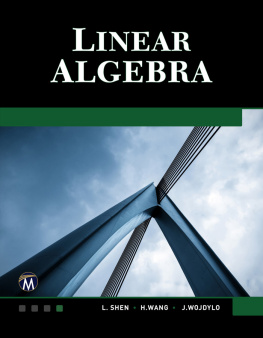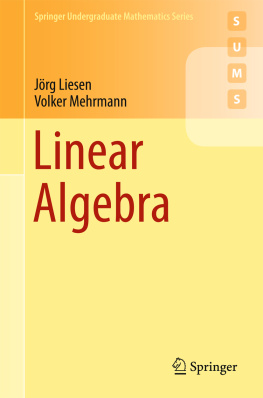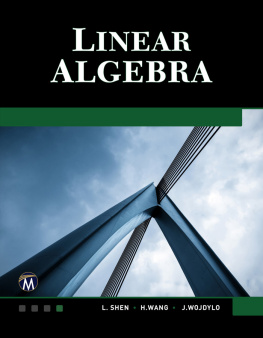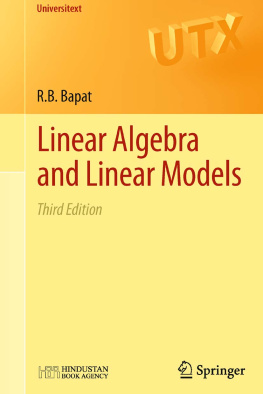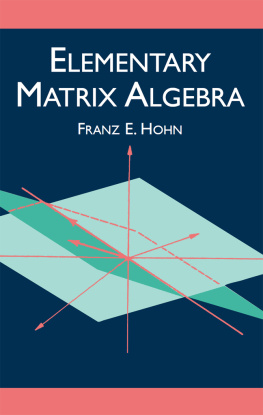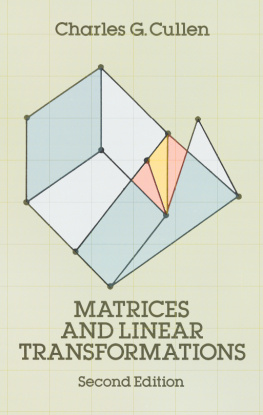Nathaniel Johnston - Advanced Linear and Matrix Algebra
Here you can read online Nathaniel Johnston - Advanced Linear and Matrix Algebra full text of the book (entire story) in english for free. Download pdf and epub, get meaning, cover and reviews about this ebook. year: 2021, publisher: Springer International Publishing, genre: Children. Description of the work, (preface) as well as reviews are available. Best literature library LitArk.com created for fans of good reading and offers a wide selection of genres:
Romance novel
Science fiction
Adventure
Detective
Science
History
Home and family
Prose
Art
Politics
Computer
Non-fiction
Religion
Business
Children
Humor
Choose a favorite category and find really read worthwhile books. Enjoy immersion in the world of imagination, feel the emotions of the characters or learn something new for yourself, make an fascinating discovery.
- Book:Advanced Linear and Matrix Algebra
- Author:
- Publisher:Springer International Publishing
- Genre:
- Year:2021
- Rating:4 / 5
- Favourites:Add to favourites
- Your mark:
- 80
- 1
- 2
- 3
- 4
- 5
Advanced Linear and Matrix Algebra: summary, description and annotation
We offer to read an annotation, description, summary or preface (depends on what the author of the book "Advanced Linear and Matrix Algebra" wrote himself). If you haven't found the necessary information about the book — write in the comments, we will try to find it.
Advanced Linear and Matrix Algebra — read online for free the complete book (whole text) full work
Below is the text of the book, divided by pages. System saving the place of the last page read, allows you to conveniently read the book "Advanced Linear and Matrix Algebra" online for free, without having to search again every time where you left off. Put a bookmark, and you can go to the page where you finished reading at any time.
Font size:
Interval:
Bookmark:
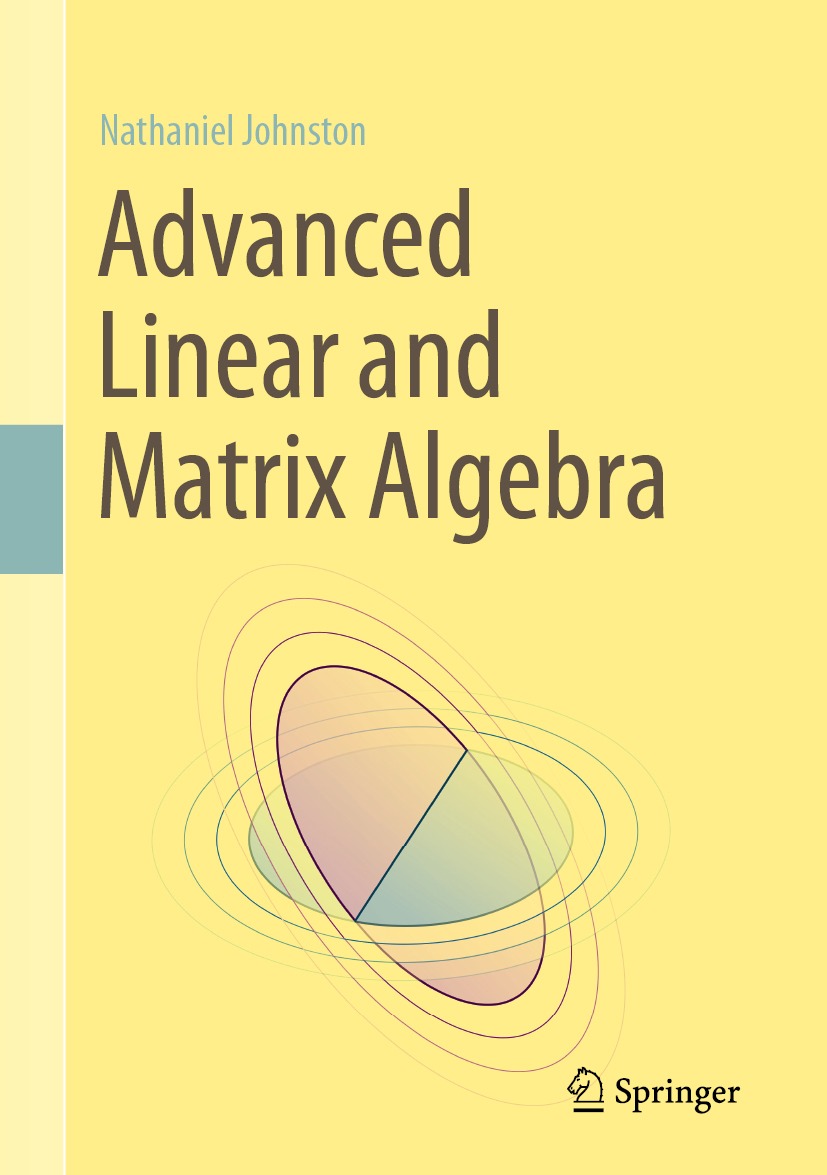

This Springer imprint is published by the registered company Springer Nature Switzerland AG
The registered company address is: Gewerbestrasse 11, 6330 Cham, Switzerland
For Devon
who was very eager at age 2 to contribute to this book:
ndfshfjds kfdshdsf kdfsh kdsfhfdsk hdfsk
Linear algebra, more so than any other mathematical subject, can be approached in numerous ways. Many textbooks present the subject in a very concrete and numerical manner, spending much of their time solving systems of linear equations and having students perform laborious row reductions on matrices. Many other books instead focus very heavily on linear transformations and other basis-independent properties, almost to the point that their connection to matrices is considered an inconvenient after-thought that students should avoid using at all costs.
This book is written from the perspective that both linear transformations and matrices are useful objects in their own right, but it is the connection between the two that really unlocks the magic of linear algebra. Sometimes when we want to know something about a linear transformation, the easiest way to get an answer is to grab onto a basis and look at the corresponding matrix. Conversely, there are many interesting families of matrices and matrix operations that seemingly have nothing to do with linear transformations, yet can nonetheless illuminate how some basis-independent objects and properties behave.
This book introduces many difficult-to-grasp objects such as vector spaces, dual spaces, and tensor products. Because it is expected that this book will accompany one of the first courses where students are exposed to such abstract concepts, we typically sandwich this abstractness between concrete examples. That is, we first introduce or emphasize a standard, prototypical example of the object to be introduced (e.g.,  ), then we discuss its abstract generalization (e.g., vector spaces), and finally we explore other specific examples of that generalization (e.g., the vector space of polynomials and the vector space of matrices).
), then we discuss its abstract generalization (e.g., vector spaces), and finally we explore other specific examples of that generalization (e.g., the vector space of polynomials and the vector space of matrices).
This book also delves somewhat deeper into matrix decompositions than most others do. We of course cover the singular value decomposition as well as several of its applications, but we also spend quite a bit of time looking at the Jordan decomposition, Schur triangularization, and spectral decomposition, and we compare and contrast them with each other to highlight when each one is appropriate to use. Computationally-motivated decompositions like the QR and Cholesky decompositions are also covered in some of this books many Extra Topic sections.
This book is the second part of a two-book series, following the book Introduction to Linear and Matrix Algebra [Joh20]. The reader is expected to be familiar with the basics of linear algebra covered in that book (as well as other introductory linear algebra books): vectors in  , the dot product, matrices and matrix multiplication, Gaussian elimination, the inverse, range, null space, rank, and determinant of a matrix, as well as eigenvalues and eigenvectors. These preliminary topics are briefly reviewed in Appendix A.1.
, the dot product, matrices and matrix multiplication, Gaussian elimination, the inverse, range, null space, rank, and determinant of a matrix, as well as eigenvalues and eigenvectors. These preliminary topics are briefly reviewed in Appendix A.1.
Because these books aim to not overlap with each other and repeat content, we do not discuss some topics that are instead explored in that book. In particular, diagonalization of a matrix via its eigenvalues and eigenvectors is discussed in the introductory book and not here. However, many extensions and variations of diagonalization, such as the spectral decomposition (Section ) are explored here.
This book makes use of numerous features to make it as easy to read and understand as possible. Here we highlight some of these features and discuss how to best make use of them.
This text makes heavy use of notes in the margin, which are used to introduce some additional terminology or provide reminders that would be distracting in the main text. They are most commonly used to try to address potential points of confusion for the reader, so it is best not to skip them.
For example, if we want to clarify why a particular piece of notation is the way it is, we do so in the margin so as to not derail the main discussion. Similarly, if we use some basic fact that students are expected to be aware of (but have perhaps forgotten) from an introductory linear algebra course, the margin will contain a brief reminder of why its true.
Several exercises can be found at the end of every section in this book, and whenever possible there are three types of them:
There are computational exercises that ask the reader to implement some algorithm or make use of the tools presented in that section to solve a numerical problem.
There are true/false exercises that test the readers critical thinking skills and reading comprehension by asking them whether some statements are true or false.
Font size:
Interval:
Bookmark:
Similar books «Advanced Linear and Matrix Algebra»
Look at similar books to Advanced Linear and Matrix Algebra. We have selected literature similar in name and meaning in the hope of providing readers with more options to find new, interesting, not yet read works.
Discussion, reviews of the book Advanced Linear and Matrix Algebra and just readers' own opinions. Leave your comments, write what you think about the work, its meaning or the main characters. Specify what exactly you liked and what you didn't like, and why you think so.



